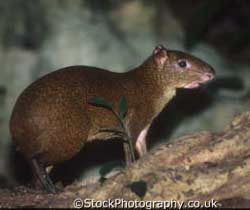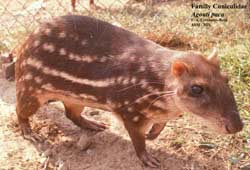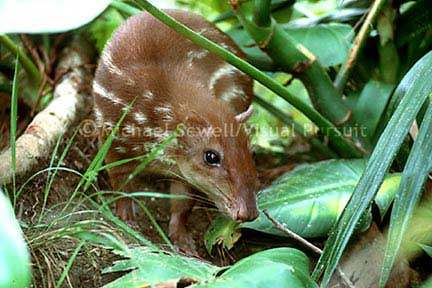The Paca: A Large Rodent of the Rainforest
The paca is a large rodent that inhabits tropical rainforests, scientifically known as Agouti paca. They are often found near water sources, preferring the banks of small streams over those of larger rivers. Pacas are excellent swimmers and typically dive into the water when threatened. While they generally lead a quiet life, they enjoy frolicking on dry leaves, creating a lot of noise.
 |
(Image: adzstock) |
The paca has a robust appearance, with dark brown fur featuring white spots along its back and sides. Its belly fur is entirely white. It has a large head, prominent cheeks, bulging eyes, and sturdy legs; the front legs have four toes, while the back legs have five. The average body length is about 79 cm (31 inches), with a short tail measuring around 3 cm (1 inch). They typically weigh around 10 kg (22 pounds) and have a distinct loud call that resembles a human laugh.
Pacas are nocturnal creatures, venturing out to forage at night and spending the day sleeping in burrows. These burrows are often dug beneath tree roots or in piles of stones along riverbanks or slopes, featuring multiple exits concealed by leaves. Their burrows usually extend about 2 meters (6.5 feet) deep.
This rodent primarily feeds on leaves, roots, and soft, easily digestible fruits. The Persea gratissima (avocado) and Mangifera indica (mango) are their favorite foods. However, they are known to damage crops by eating cassava, sugarcane, corn, and various other plants. Pacas cannot climb, so when they want fruit, they must wait for animals that live in trees, like monkeys, to drop fruit to the ground. During fruit-rich seasons, they consume large amounts and can become plump, resembling pigs. When fruit becomes scarce, they shift to eating mostly leaves, which can make them susceptible to illness.
The Unique Digestive System of the Paca:
 |
| (Image: mammalogy) |
The paca’s long and large intestines are well-suited for digesting leaves due to bacterial fermentation. Interestingly, pacas practice coprophagy, meaning they consume their own feces. This process allows their bodies to extract remaining nutrients from the feces they just excreted.
Most of their lives are spent in solitude. Female pacas reach sexual maturity at about one year of age, giving birth to two litters per year, with each litter typically consisting of one, but occasionally two, offspring. The gestation period lasts approximately 118 days.
In the wild, jaguars are known predators of this rodent species. Pacas avoid predators by swimming underwater and only emerge from their burrows in the evening to search for food. Young pacas face a high mortality rate during fruit scarcity (from November to March) due to hunger and increased vulnerability to predators, as they are forced to roam outside more in search of food.
In some regions, pacas are at risk of extinction due to overhunting by humans. Their meat is considered delicious and fatty, making them one of the most hunted species in Central and South America. Their meat holds significant market value. Additionally, they are ruthlessly exterminated due to crop damage.
Pacas are distributed from southern Mexico to Brazil. Their lifespan in the wild is about 3.5 years, while those in captivity may live up to 7 years.

(Image: visualpursuit)


















































